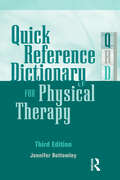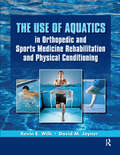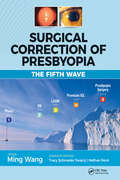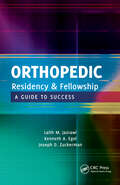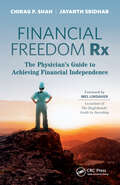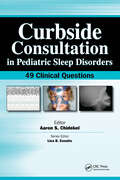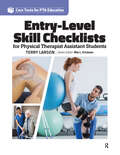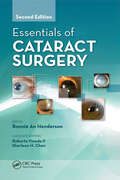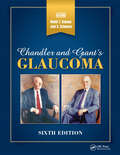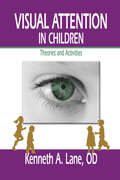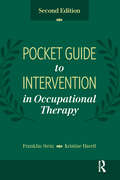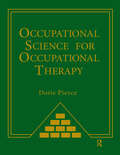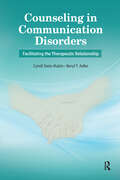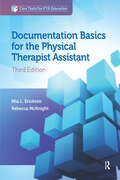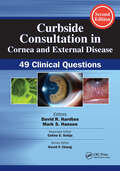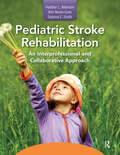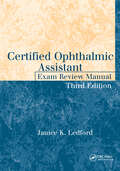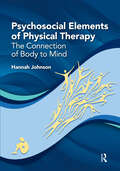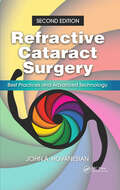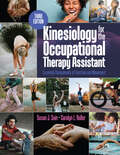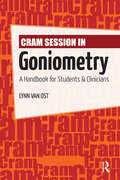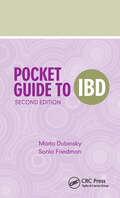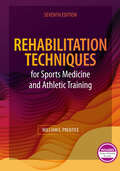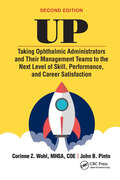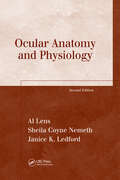- Table View
- List View
Quick Reference Dictionary for Physical Therapy
by Jennifer BottomleyQuick Reference Dictionary for Physical Therapy has been revised and updated into a Third Edition to include the latest information in the field of physical therapy. This reference book, designed specifically for the physical therapy and physical therapist assistant student and practitioner, provides a magnitude of terms, definitions, guidelines, and references essential to the field. This Third Edition provides quick access to over 3400 words and their definitions that are encountered on a day-to-day basis (400 more than the previous edition). There are also 41 appendices in this user-friendly, pocket-sized reference where you can find information such as lists of general acronyms and abbreviations for words commonly used in physical therapy/rehabilitation; commonly used acronyms for evaluative tests and measures; and definitions of impairment, disability, and handicap as established and accepted by the World Health Organization. What is new inside the Third Edition:• More than 100 new abbreviations and acronyms• Updated Code of Ethics for the Physical Therapist• A new Drug Prescribing and Elimination Abbreviations appendix• Updates to suggested readingsQuick Reference Dictionary for Physical Therapy, Third Edition is the perfect, pocket size, affordable companion for school, clinical affiliations, and physical therapy practice.
The Use of Aquatics in Orthopedics and Sports Medicine Rehabilitation and Physical Conditioning
by David Joyner Kevin WilkThe Use of Aquatics in Orthopedic and Sports Medicine Rehabilitation and Physical Conditioning is a definitive and scientifically based text on the use and application of aquatic methodologies in both rehabilitation and physical conditioning appropriate for the general population to the elite athlete.The Use of Aquatics in Orthopedic and Sports Medicine Rehabilitation and Physical Conditioning represents a new generation of rehabilitation that is informative enough to be injury and sports specific. Dr. Kevin E. Wilk and Dr. David M. Joyner, along with noted domestic and international leaders in the field, explore the aquatic techniques and principles detailed in the work, while presenting this scientifically based material in an understandable and user-friendly format. Ten chapters take the reader from the history of aquatic rehabilitation and progress to discuss all parameters of aquatic rehabilitation.Some chapter topics include:• History, theory, and applications of aquatic therapy• Pool selection, facility design, and engineering considerations• Rehabilitation for the upper and lower extremities and spine• Sports-specific training• Research evidence for the benefits of aquatic exercise• Appendices, including 4 specific protocols for various lesions and disordersThe Use of Aquatics in Orthopedic and Sports Medicine Rehabilitation and Physical Conditioning represents a new era in the use and development of aquatic therapy in sports medicine rehabilitation and is perfect for physical therapists, athletic trainers, strength and conditioning coaches, personal trainers, and sports medicine professionals alike.
Surgical Correction of Presbyopia: The Fifth Wave
by Ming WangUntil recently, surgical correction of presbyopia was considered the “last frontier” in ophthalmology, but today there are a wide variety of treatments available. This Fifth Wave of ophthalmology opens up a whole world of surgical solutions for presbyopes who would otherwise have no recourse, and Surgical Correction of Presbyopia: The Fifth Wave is designed as a complete guide to the wide range of surgical solutions available. Dr. Ming Wang is joined by Associate Editors Drs. Tracy Schroeder Swartz and Nathan Rock and their all-star team of expert contributors to compile the first comprehensive review of all the state-of-the-art surgical treatments for presbyopia. This includes a history of refractive and lens surgery, a review of presbyopia and its medical management, as well as in-depth sections on not only those surgical treatments that are currently available but also those under active clinical investigation. Inside Surgical Correction of Presbyopiais a detailed presentation on corneal solutions, including laser treatments and corneal inlays; lenticular solutions, including intraocular lenses; and scleral solutions, such as scleral implants and ablation. Each procedure features a discussion on the indications, benefits, results and risks of the procedure with close attention to clinical applications. Also included are chapters on complex cases, which focus on improving outcomes both with patient and surgical modality selection and postoperative management.Chapters include: Excimer and Femtosecond LASER for Treatment of Presbyopia Shape-Changing Inlays Multifocal Intraocular Lenses Extended Depth of Focus Intraocular Lenses Laser Scleral Microablation Procedure Marketing Surgical Treatment for Presbyopia The Future of Presbyopia Treatment Presbyopia is the most common refractive condition and more patients and providers are actively seeking surgical solutions. With Surgical Correction of Presbyopia: The Fifth Wave, anyone from ophthalmology technicians and opticians to practicing ophthalmologists and optometrists will confidently understand and be prepared to tackle this “last frontier” of ophthalmology.
Orthopedic Residency and Fellowship: A Guide to Success
by Kenneth Egol Joseph Zuckerman Laith JazrawiOrthopedic surgery remains one of the most competitive subspecialties in medicine. This “how- to” guide describes how medical students can achieve their goal of being accepted into an orthopedic residency program and how to thrive once there.What will you learn from Orthopedic Residency and Fellowship: A Guide to Success?• How medical students can achieve their goal of being accepted into an orthopedic residency program• How to succeed during and after your residency• Tips and pearls to maximize your experience• Budgeting your time• Peer interaction• Job placement• How to read a contract• How to decide between academic or private practice• Asset protection • Making the right financial decisionOrthopedic Residency and Fellowship: A Guide to Success by Drs. Laith M. Jazrawi, Kenneth A. Egol and Joseph D. Zuckerman is the only book on the market that solely focuses on getting into an orthopedic residency or fellowship training program, excelling once you are there, and maximizing and obtaining the right practice opportunity for you. Providing easy-to-read chapters and quick reference materials, this book is a must-read for anyone interested in the field of musculoskeletal care.
Financial Freedom Rx: The Physician’s Guide to Achieving Financial Independence
by Chirag Shah Jayanth Sridhar"The best physician-specific general financial book published in 2021." —James M. Dahle, MD, author of The White Coat InvestorA step-by-step guidebook for doctors and other medical professionals about growing and preserving wealth, Financial Freedom Rx: The Physician’s Guide to Achieving Financial Independence gives physicians all the tools necessary to manage their own finances and includes a foreword by Mel Lindauer, co-author of The Bogleheads' Guide to Investing. Medical professionals, especially doctors, spend many years in training as they accumulate debt and delay their earnings. This book presents a time-tested formula that students and established professionals can follow at any stage during their careers to achieve fiscal peace of mind. Students will learn how to budget and adopt disciplined financial practices. Residents and other trainees will learn how to defend against calamity with various insurances and how to manage debt. Junior professionals will acquire the skills needed to invest and grow their portfolios, while senior professionals will better understand the essentials of estate planning and retirement. Drs. Chirag P. Shah and Jayanth Sridhar wrote this inspiring text to guide physicians where to put their next dollar. This is particularly important during the financial uncertainties brought on by COVID-19 and insurance cuts. Financial Freedom Rx sets forth principles that will pilot medical professionals toward financial independence. Chapters include useful advice on topics such as: Financial planning Investing and asset allocation Jobs and contracts Taxes and insurance Student loans and debt Retirement savings and distributions Financial Freedom Rx: The Physician’s Guide to Achieving Financial Independence serves as a timeless blueprint for financial planning that medical professionals will follow throughout their careers, and as a reference that readers will revisit again and again as they progress through the various stages of life.
Curbside Consultation in Pediatric Sleep Disorders: 49 Clinical Questions (Curbside Consultation in Pediatrics)
by Aaron ChidekelAre you looking for concise, practical answers to those questions that are often left unanswered by traditional pediatric sleep disorder references? Are you seeking brief, evidence-based advice for complicated cases or controversial decisions? Curbside Consultation in Pediatric Sleep Disorders: 49 Clinical Questions provides quick answers to the tricky questions most commonly posed during a “curbside consultation” between pediatricians. Dr. Aaron Chidekel has designed this unique reference which offers expert advice, preferences, and opinions on tough clinical questions commonly associated with pediatric sleep disorders. The unique Q&A format provides quick access to current information related to pediatric sleep disorders with the simplicity of a conversation between two colleagues. Numerous images, diagrams, and references allow readers to browse large amounts of information in an expedited fashion.Some of the questions that are answered: Why do we sleep and what is happening when children sleep? How does sleep change from infancy to adulthood? What are the latest recommendations for safe infant sleep and the prevention of SIDS? What are some pearls or strategies to manage or even better, to prevent behavioral sleep disorders in young children? What is obstructive sleep apnea syndrome? What is narcolepsy and do children actually develop this condition? Which of my patients should have a polysomnogram? Curbside Consultation in Pediatric Sleep Disorders: 49 Clinical Questions provides information basic enough for residents while also incorporating expert advice that even high-volume pediatricians will appreciate. Pediatricians, family practitioners, and pediatric residents will benefit from the user-friendly, casual format and the expert advice contained within.
Entry Level Skill Checklists for Physical Therapist Assistant Students (Core Texts for PTA Education)
by Terry LarsonA new resource to support and track student development across PTA programs, Entry-Level Skill Checklists for Physical Therapist Assistant Studentsis a visually appealing lab manual that includes entry-level PTA skills in a user-friendly, step-by-step checklist format.Written by seasoned PT and PTA instructor Dr. Terry Larson, Entry-Level Skill Checklists for Physical Therapist Assistant Studentscombines skill and evaluation measures into checklists so instructors may track their students’ progress with ease. The book is meant to follow students throughout their programs of study—from their first lab course to submission at the end of their program. Created to reflect the Commission on Accreditation in Physical Therapy Education guidelines, Entry-Level Skill Checklists for Physical Therapist Assistant Studentsis the latest entry into SLACK Books’ Core Texts for PTA Education series.What’s included in Entry-Level Skill Checklists for Physical Therapist Assistant Students: Sections on data collection and intervention Checklists following each skill stage to record and evaluate progress Checkboxes for peer evaluation and instructor assessment Comment areas for instructors to provide feedback on development of student abilities Across courses and programs, Entry-Level Skill Checklists for Physical Therapist Assistant Students will help students facilitate self-evaluation and professors gauge and document student progress in any PTA program.
Essentials of Cataract Surgery
by Bonnie HendersonThe straightforward, concise, and easy-to-read reference manual which is equivalent to having the best instructor offering guidance on what to do next and how to avoid potential complications is now available in an updated Second Edition.Essentials of Cataract Surgery, Second Edition comprehensively details every step of phacoemulsification cataract extraction surgery, from preoperative evaluation to intraoperative instruction to postoperative care. The basic elements of cataract surgery are presented in a clear and easy-to-read format.Dr. Bonnie An Henderson brings together advice and teaching techniques from the Harvard Intensive Cataract Surgical Training Conference at the Massachusetts Eye and Ear Infirmary. The book provides both beginning and practicing surgeons with personal tips and expert advice from leading cataract mentors of top US ophthalmology residency programs. Inside Essentials of Cataract Surgery, Second Edition are detailed chapters covering fluidics, IOL calculations and design, capsular complications and management, and the latest phaco technology, including femtosecond cataract surgery. Each chapter contains a summary box, highlighting the key points of each topic discussed. Additionally, the included images, diagrams, photographs, and tables enhance understanding of specific topics.With detailed information and expert pearls in a user-friendly format, Essentials of Cataract Surgery, Second Edition is perfect for residents, fellows, medical students, and practicing ophthalmologists looking to improve their surgical techniques.
Chandler and Grant's Glaucoma
by Malik Kahook Joel S. SchumanChandler and Grant’s Glaucoma—one of the field’s seminal texts on the medical practice and surgical management of glaucoma, now in its Sixth Edition—includes the latest updates in an area that is currently experiencing a surge of innovation. Edited by Drs. Malik Y. Kahook and Joel S. Schuman and with writings from the late Dr. David L. Epstein and more than 80 contributors, Chandler and Grant’s Glaucoma, Sixth Edition brings together the experience of world-class glaucoma experts who belong to a long line of surgeons trained using the teachings of the original authors of this classic work. Each chapter has been meticulously edited and updated from the previous edition, while maintaining the well-established historical teachings of Drs. Paul A. Chandler and W. Morton Grant. New chapters on medical therapy as well as thorough updates on novel and minimally invasive approaches for the surgical management of glaucoma have been added. New topics and features in the Sixth Edition include: Advances in imaging of the optic nerve and retina Rho-associated protein kinase inhibitors Glaucoma and cerebrospinal fluid pressure The FDA’s role in the development of new diagnostic and surgical devices for patients with glaucoma Chandler and Grant’s Glaucoma has been the most relevant and invaluable reference on glaucoma for generations of ophthalmologists. This updated Sixth Edition builds on the teachings of previous editions, making the Sixth Edition as relevant in the 21st century as when the first lectures were presented by Drs. Chandler and Grant more than 55 years ago.
Visual Attention in Children: Theories and Activities
by Kenneth LaneIn typical child development, attention controls many aspects of learning, including memory, motor control, and problem solving. Attention organizes the constant influx of information that needs to be absorbed by children. Inside Visual Attention in Children: Theories and Activities, Dr. Kenneth A. Lane describes the positive aspects of attention that are needed for children to be successful in the classroom, such as concentration and vigilance, as opposed to negative aspects that can lead to failure, such as distractibility and confusion. This book is divided into two parts. The first eight chapters of the book explain attention and its relationship to vision and visual stimuli. The core topics discussed here include Autism, ADHD, Dyslexia, Executive Function, and Memory. The second half outlines a Vision Therapy program and consists of activities for improving visual attention in children. Over 100 activities are explained and illustrated.Visual Attention in Children: Theories and Activities is anchored on current theories in five areas of attention that shape child development.Theories Described Include:• Focused Attention – The ability to respond discreetly to visual, auditory, and tactile stimuli• Selective Attention – The ability to maintain behavioral or cognitive abilities in the face of distracting or competing stimuli• Shifting Attention – The ability to rapidly shift attention from one object to another• Sustained Attention – The ability to maintain a consistent behavioral response during a continuous or repetitive activity• Divided Attention –The ability to engage in more than one attention-focused task at one time.Visual Attention in Children: Theories and Activities is the perfect tool for occupational therapy students and clinicians as well as other professionals specializing in child development and learning who are looking to enhance their understanding of this topic and who need unique ideas and activities to add to their visual therapy training programs.
Pocket Guide to Intervention in Occupational Therapy
by Kristine Haertl Franklin SteinPocket Guide to Intervention in Occupational Therapy, Second Edition builds upon the strengths of the first edition as a useful quick reference of occupational therapy terms and interventions regarding specific diagnoses and conditions. Occupational therapy is an evidence-based health care profession that uses scientifically based research to justify clinical practice. Interventions in hospitals, clinics, and community and school settings continue to evolve based on scientific evidence. These interventions are intended to prevent injury and maintain or improve client function. Pocket Guide to Intervention in Occupational Therapy, Second Edition by Dr. Franklin Stein and Dr. Kristine Haertl is organized around the major conditions that occupational therapists encounter in their everyday practice. These include physical, psychosocial, cognitive, geriatric, and pediatric diagnoses. Intervention guidelines are outlined for the major disabilities. In addition, there are brief descriptions of the intervention techniques that therapists use and definitions of terms that are relevant to interventions. Intervention techniques encompass the following: Non-medical techniques such as client health education or counseling Instruction in activities of daily living, modifying of environment such as in ergonomics Teaching and demonstrating arts and crafts as therapeutic activities Providing sensory stimulating activities especially for children The appendices include an outline of essential skills for occupational therapists, general developmental guidelines, an overview of muscles and movements, orthotic devices, tables of muscles, average range of motion measurements, prime movers for upper and selected lower extremity motions, and substitutions for muscle contractions.Pocket Guide to Intervention in Occupational Therapy, Second Edition is based on the latest scientific evidence garnered from recent research studies, meta-analyses, scoping reviews, occupational therapy textbooks and their own wide experiences as a clinician, professor and researcher.
Occupational Science for Occupational Therapy
by Doris PierceOccupational Science for Occupational Therapyarticulates how occupational science research produces unique insights into occupation and increases the effectiveness of occupational therapy interventions. This text illustrates the four key types of knowledge now being researched in occupational science: descriptive, relational, predictive, and prescriptive. This text also offers a comprehensive review of occupational science’s history of emergence from the needs and interests of occupational therapy, conflicting origins and intents, and ongoing development as a discipline within academia. In Occupational Science for Occupational Therapy, Dr. Doris Pierce and an outstanding group of occupational scientists explain how their discoveries build the science and support practice. A rich variety of methods and perspectives mark the work of these career scientists as they respond to the knowledge base needs of occupational therapy. This fully evidence-based text also brings the research experience alive for occupational therapy students, describing the passions, challenges, and choices that are the reality of research as an occupation. All research chapters discuss how findings build both science and practice, including learning supports in which students can try out research activities, explore assessment, or develop interventions. Most importantly, Occupational Science for Occupational Therapyprovides new and experienced practitioners a thorough exploration of the latest research in occupation-based practice.Occupational Science for Occupational Therapy synthesizes key works by occupational scientists, including a foreword by Dr. Elizabeth Yerxa, founder of the science. Occupational therapy and occupational science students, practitioners, and faculty will especially appreciate this book’s comprehensive coverage of work by current leaders of research on occupation-based practice.
Counseling in Communication Disorders: Facilitating the Therapeutic Relationship
by Cyndi Stein-Rubin Beryl AdlerIncorporating a counseling paradigm has been shown to increase motivation, deepen learning, and sustain progress for clients and families. Counseling in Communication Disorders: Facilitating the Therapeutic Relationship by Cyndi Stein-Rubin and Beryl T. Adler, is an engaging textbook, written in a genuine and lively tone, so that the reader may easily relate to the material. The text provides a practical vehicle for speech-language pathology students, clinicians, clinical supervisors, and instructors to get to know themselves better and to integrate basic counseling attitudes and tools into their diagnostic and therapeutic programs. Inside Counseling in Communication Disorders, Stein-Rubin and Adler describe the importance of addressing a client’s communication challenges by working with the whole person, as a human being, not as a communication disorder. By approaching clients with a counseling attitude that encourages the client’s full participation in the treatment process, we then work together in partnership and as a powerful team. The content, techniques, and exercises within Counseling in Communication Disorders are rooted in evidence-based practice from a variety of psychological, counseling, and coaching approaches, such as Humanistic Counseling, Listening and Language, Narrative Therapy, The Cognitive Behavioral Model (CBT), Solution-Focused Brief Therapy (SFBT), Positive Psychology, Neurolinguistic Programming (NLP), and Mindfulness training.Counseling in Communication Disorders also includes reflective questions, exercises, and suggestions to reinforce important concepts. To bring the content to life, real-life and clinical scenarios are interspersed throughout the text.It is well understood that speech-language pathology and audiology clinicians must understand deep listening and how to choose words that will have a positive impact on their client and families, but often overlooked is the personal development of the clinicians themselves. Counseling in Communication Disorders is a comprehensive guide on how to provide the necessary support and encouragement to clients and build self-esteem, while a major focus is the need for the clinicians to work on self before working on other. Counseling in Communication Disorders: Facilitating the Therapeutic Relationship is the first textbook of its kind to comprehensively cover both sides of the therapeutic relationship. Students and clinicians alike will appreciate this unique approach that addresses not only the counseling attitude that is vital to the growth and progress of clients, but also the self-awareness that guides the personal development of the clinician.Included with the text are online supplemental materials for faculty use in the classroom.
Documentation Basics for the Physical Therapist Assistant (Core Texts for PTA Education)
by Mia Erickson Rebecca McKnightComplete and accurate documentation is one of the most important skills for a physical therapist assistant to develop and use effectively. The new Third Edition of Documentation Basics for the Physical Therapist Assistant continues the path of teaching the student and clinician documentation from A to Z. Mia Erickson and Rebecca McKnight have updated this Third Edition to reflect changes in the ever-evolving profession. Newly addressed are the changes in documentation requirements for major payers, changes in the disablement models used, and the increasingly common use of electronic documentation in the physical therapy profession. Features inside the Third Edition: Readers are encouraged to think about disablement and disablement concepts when writing notes How to document impairments in body structure and function but more importantly activity limitations and participation restriction Descriptions of the differences in documentation methods using a computer vs paper chart Evidence tied to benefits and challenges of computerized documentation Documenting the rationale for treatment and the unique skills of the physical therapist assistant in patient management New inside the Third Edition: Incorporation of the International Classification of Functioning, Disability, and Health disablement model Chapter on electronic documentation Screenshot examples of the popular WebPT® electronic medical record platform Updated chapters on reimbursement and legal issues Additional examples for student practice included in each chapter Included with the text are online supplemental materials for faculty use in the classroom. Documentation Basics for the Physical Therapist Assistant, Third Edition is the perfect guide for all physical therapist assistant students and clinicians who want to update and refine their knowledge and skills in documentation.
Curbside Consultation in Cornea and External Disease: 49 Clinical Questions (Curbside Consultation in Ophthalmology)
by Mark Hansen David R. Hardten Celine SatijaCurbside Consultation in Cornea and External Disease, Second Edition contains new questions and brief, practical, evidence-based answers to the most frequently asked questions that are posed during a “curbside consultation” between clinicians. Dr. David R. Hardten and associate editors Drs. Mark S. Hansen and Celine Satija have designed this unique reference in which cornea and external disease specialists offer expert advice, preferences, and opinions on tough clinical questions commonly encountered by corneal specialists, ophthalmologists, or residents. The unique Q&A format provides quick access to current information with the simplicity of a conversation between two colleagues. Numerous images, diagrams, and references are included to enhance the text and illustrate clinical diagnoses and treatment plans. Some of the questions that are answered inside the Second Edition include: I have a patient with Fuchs' Endothelial Dystrophy. Is there anything new to improve her vision? What should I do with a young patient with mild keratoconus? How can I help a 47-year-old female who uses artificial tears 6 times daily and continues to complain of dry eyes? A patient presents with corneal ulcer. What work-up and treatment would you recommend? How do I manage a patient that rubbed their eye just after LASIK? What could go wrong? What can I offer a patient that sustained eye trauma and loss of iris tissue? I have a patient with poor vision after DMEK. What went wrong and how do I get better vision for them? Curbside Consultation in Cornea and External Disease: 49 Clinical Questions, Second Edition provides information basic enough for residents while also incorporating expert pearls that even high-volume ophthalmologists will appreciate. Cornea specialists, general ophthalmologists, and residents alike will enjoy the user-friendly and casual format and the expert advice contained within.
Pediatric Stroke Rehabilitation: An Interprofessional and Collaborative Approach
by Sabrina Smith Heather Atkinson Kim Nixon-CavePediatric Stroke Rehabilitation: An Interprofessional and Collaborative Approach is a groundbreaking text designed to enhance the practice of all health care providers, enrich discussion, and emphasize the interdisciplinary nature of managing best outcomes for a child who has had a stroke. Evidence-based practice is threaded throughout the text with an emphasis on recovery vs. compensation, goal achievement, and outcome measurement.In conjunction with the interdisciplinary contributions from a wide variety of health care professionals, Drs. Heather Atkinson, Kim Nixon-Cave, and Sabrina E. Smith aim to provide the necessary tools to effectively treat children with stroke.The first section reviews the medical fundamentals, covering all major types of strokes. The second section of Pediatric Stroke Rehabilitation focuses on the core of the matter, rehabilitation. The final section expands the understanding of the child’s recovery to the family, community, and school environment.Select chapters include: Personal vignettes written by family members of children who have had a stroke that provides insight into the impact a stroke can have on the child and family A family focus box to summarize the main points of the chapter to provide the best tools for caregivers to advocate for their child A case study related to the content and family perspective Pediatric Stroke Rehabilitation also utilizes the World Health Organization’s International Classification of Functioning, Disability, and Health (ICF) framework throughout.Included with the text are online supplemental materials for faculty use in the classroom.Pediatric Stroke Rehabilitation: An Interprofessional and Collaborative Approach is an interdisciplinary and invaluable resource for students and clinicians to understand and apply effective evidence-based practice and treatment approaches for childhood stroke. The text will also be of interest to healthcare professionals, specifically physical therapists, occupational therapists, speech-language pathologists, physicians, neuropsychologists, nurses, and educators, who work with children who have experienced a stroke.
Certified Ophthalmic Assistant Exam Review Manual (The Basic Bookshelf for Eyecare Professionals)
by Janice K. LedfordThe best-selling exam preparation manual for more than 15 years has been extensively updated into a Third Edition. With revisions and additional material that match the new JCAHPO® criteria for Certified Ophthalmic Assistants (COA®), this study resource will remain the top choice for those studying for certification. With nearly 1,400 questions, the Certified Ophthalmic Assistant Exam Review Manual, Third Edition contains more questions with explanatory answers than any other study aid. Additionally, all 19 exam criteria headings are covered inside, including history taking, visual assessment, medical ethics, pharmacology, ophthalmic imaging, surgery, and more. Features:• Study tips, hints, and test-taking strategies• Explanatory answers for every question• Updated to reflect new JCAHPO COA exam criteriaCertified Ophthalmic Assistant Exam Review Manual, Third Edition by Janice K. Ledford will be the most talked-about resource for those studying for the COA® exam, students in ophthalmic and optometric assisting programs, and those who wish to review before taking the COT® exam.
Psychosocial Elements of Physical Therapy: The Connection of Body to Mind
by Hannah JohnsonPhysical therapists know that their patients are more than just a list of symptoms. They are people first, often with a complex mix of medical and psychiatric circumstances, who may receive a wide range of care from a team of professionals. Keeping this in mind, Psychosocial Elements of Physical Therapy: The Connection of Body to Mind is both a textbook and a clinical resource for physical therapist students and clinicians practicing in any patient population with psychological concerns or disorders.Inside, Dr. Hannah Johnson provides an essential introduction of psychosocial concepts, general treatment approaches for culturally sensitive care, and selected classes of mental illness as defined by the Diagnostic and Statistical Manual of Mental Disorders, 5th Edition (DSM-5). A complete review of the current research and evidence base provides students a strong foundation to build their careers on, but can also act as a crash-course in the most recent literature for the busy clinician.Features: Clear, concise language and layout for efficient learning Application-based review questions Real world case studies to apply critical thinking skills Evidence-based practical tests and measures Vocabulary terms that facilitate interdisciplinary teamwork Psychosocial Elements of Physical Therapy: The Connection of Body to Mind provides physical therapist students and clinicians with an efficient yet comprehensive guide to helping patients with psychological concerns or disorders.
Refractive Cataract Surgery: Best Practices and Advanced Technology
by John HovanesianUpdated and expanded, this Second Edition of Refractive Cataract Surgery: Best Practices and Advanced Technology is a practical guide for cataract surgeons and general ophthalmologists who wish to take their practices to a new level by offering refractive solutions to their cataract patients. All chapters have been updated to provide the latest information on premium surgery, including how-to chapters on extended depth-of-focus implants, intraoperative aberrometry, and femtosecond laser surgery. Both well-established and cutting-edge implants and techniques are presented in chapters that are organized by topic and detailed step-by-step. Dr. John A. Hovanesian and his contributors include enhancement strategies such as piggyback lenses, laser enhancement, and incisional surgery which are presented as separate and complete solutions. In addition to surgical strategies, Refractive Cataract Surgery, Second Edition explains the psychology of creating a premium practice. Non-technical matters such as patient screening, ethics, communicating the value of lenses, and managing the unhappy patient are thoroughly presented with easy-to-adopt ideas. New in the Second Edition: Intraoperative aberrometry Femtosecond laser cataract surgery Diagnostic and management tools for ocular surface disease Extended depth-of-focus implants Updated information on Tecnis toric, Trulign, and other accommodating IOLs Advice on various pricing models Refractive Cataract Surgery: Best Practices and Advanced Technology, Second Edition explores every angle of premium surgery and practice and offers improvements for all levels of surgeons, from the resident to the experienced physician, resulting in a top experience and a lifetime of premium vision for the patient.
Kinesiology for the Occupational Therapy Assistant: Essential Components of Function and Movement
by Susan Sain Carolyn RollerThe only kinesiology book written by occupational therapy practitioners for the occupational therapy assistant is back with the Third Edition.Kinesiology for the Occupational Therapy Assistant: Essential Components of Function and Movement, Third Edition approaches the study of kinesiology by connecting function to the underlying components that make movement possible.This text uses a top-down approach to showcase the functional level of a client and then guides the reader to ascertain what fundamental kinesiological functions may be causing limitations or decreased engagement in daily activities. Occupational profiles introduce occupational therapy assistant students to real-life patients and describe occupational therapy treatment and patient outcomes. The reader will gain insight into the practice of occupational therapy through solving problems and developing questions needed to assist the client to achieve movement-related goals in tasks, activities, and occupations.What’s included in the Third Edition:• Updates to reflect AOTA’s model curricula for basic sciences and the OTPF-4. • Chapters on kinesiology and therapeutic exercise as well as functional mobility in the home and community.• Emphasis on function and identification of how and why movement occurs.• Select standardized tests, pinch and grip strength, and range of motion norms are noted where appropriate.Included with the text are online supplemental materials for faculty use in the classroom.Kinesiology for the Occupational Therapy Assistant: Essential Components of Function and Movement, Third Edition is a one-of-a-kind text that will enable occupational therapy assistant students to identify the underlying components that make movement possible.
Cram Session in Goniometry: A Handbook for Students and Clinicians
by Lynn Van OstWhen all you need is a basic understanding of goniometry. When concise and illustrative examples of goniometric techniques will provide exactly what the rehabilitation professional needs—Look to Cram Session in Goniometry: A Handbook for Students and Clinicians for quick and “at your fingertips” facts.Cram Session in Goniometry by Lynn Van Ost is a concise and abundantly illustrated quick reference which provides the rehabilitation professional with a very basic approach to various goniometric techniques. Organized in a “head to toe” format, Cram Session in Goniometry takes user-friendly and efficient learning to a new level.What is in your “Cram Session”:• Photographs depicting each goniometric measurement• Breakdown of each body region covered• Each type of joint, capsular pattern, average range of motion, patient positioning, goniometric alignment, patient substitutions, and alternative methods of measurement• Over 190 photographsCram Session in Goniometry: A Handbook for Students and Clinicians is an informative, well-organized handbook for all students and clinicians in physical therapy, occupational therapy, athletic training and orthopedics.
Pocket Guide to IBD
by Sonia Friedman Marla DubinskyPocket Guide to IBD, Second Edition is designed to provide quick clinical information for gastroenterologists, primary care physicians, physician assistants, and nurse practitioners who need to review symptoms, medications, and disease management, in order to decide effective diagnoses and treatments for their patients with IBD.Some of the topics covered are:• Special populations, including pregnancy and children• Vaccinations in the patient with IBD• Treatment of the infliximab refractory patient• Diagnosis and treatment of perianal disease• Care of the post operative patientDr. Marla Dubinsky and Dr. Sonia Friedman have created this go-to reference for one of the most popular topics among practicing gastroenterologists and other GI and primary care providers.Features:• Comprehensive chapters in quick reference format• Symptom-based guide for diagnosis and treatment • Tables highlighting the full array of IBD medications • Charts and figures detailing complete treatment algorithmsThe Pocket Guide to IBD, Second Edition is unique in its size, accessibility of information, thoroughness, and clarity of content. This clinical guide will be the quick reference to turn to when treating patients with IBD.
Rehabilitation Techniques for Sports Medicine and Athletic Training
by William PrenticeRehabilitation Techniques for Sports Medicine and Athletic Training, Seventh Edition is the definitive reference for athletic training students and professionals who are interested in gaining more in-depth exposure to the theory and practical application of rehabilitation techniques used in a sports medicine environment.Dr. William Prentice and his contributors have combined their knowledge and expertise to produce a single text that encompasses all aspects of sports medicine rehabilitation. Featuring more than 1,000 full-color illustrations, 700 high-resolution videos, and an integrated laboratory manual, this newly updated Seventh Edition provides the athletic trainer with a complete guide to the design, implementation, and supervision of rehabilitation programs for sport-related injuries.The Seventh Edition includes new and updated information on topics including:• Pharmacology and the role of medication in pain management and performance• Nutrition and its impact on rehabilitation• Rehabilitation techniques for the core • Roles within the rehabilitation team• Pathomechanics and epidemiology of common injuries• Psychological considerations and communication with injured patients• Tips for documentation from Dr. Prentice Included with the text are online supplemental materials for faculty use in the classroom.Rehabilitation Techniques for Sports Medicine and Athletic Training, Seventh Editionis a comprehensive resource for athletic training students, faculty, and clinicians; physical therapists who manage rehabilitation programs for sports-related injuries; as well as for strength and conditioning coaches who supervise performance enhancement programs on return to play.
UP: Taking Ophthalmic Administrators and Their Management Teams to the Next Level of Skill, Performance and Career Satisfaction
by John B. Pinto Corinne WohlLike having an expert mentor in your pocket, UP is a powerful, practical workbook designed to take ophthalmic administrators and practice managers to the next level of their careers, offering practical tips, concrete advice, and a step-by-step guide for any hurdle they face. Authors Corinne Wohl and John Pinto are undisputed experts in the field, having decades of experience advising ophthalmic practices of all sizes and publishing numerous books and articles on the subject. In this book, Wohl and Pinto guide administrators toward best practices in coaching and developing their entire management team. UP is also a helpful tool for physician leaders (and leaders in training), who can only accomplish their board-level goals through effective lay managers.UP provides readers with: Practical tips on how to create a customized support and development program for each manager and administrator A step-by-step process for better problem solving Worksheets, insightful self-tests, and scorecards for immediate use as part of a linear career development program
Ocular Anatomy and Physiology (The Basic Bookshelf for Eyecare Professionals)
by Janice K. Ledford Al Lens Sheila Coyne NemethUpdated to include new material for beginners in ophthalmology and optometry, Ocular Anatomy and Physiology, Second Edition is an essential text that covers a range of fundamental information for students and clinicians. With collaborations from Al Lens, Sheila Coyne Nemeth, and Janice K. Ledford, Ocular Anatomy and Physiology, Second Edition now begins with a jump-start chapter to overview the topic for those new to the field of eye care. Chapter two delves into embryology—a topic rarely covered—and addresses each structure of the eye, including the bony orbit, eyebrows, eye lids, lacrimal system, extraocular muscles, and the globe. While the text continues to emphasize normal anatomy, each chapter contains a glossary of common disorders. Also included is a description of diagnostic methods for examining various tissues. The physiology of various structures and systems is explained, including the visual pathway, the inflammatory response, immunology, binocular vision, refractive errors, and accommodation. To enhance the reader’s understanding of each topic, illustrations are provided.Features of the Second Edition: New jump-start chapter for beginners Details on diagnostic methods for each structure or segment, including optical coherence tomography and retinal thickness analysis Glossary of common disorders at the end of each chapter With new features and information, Ocular Anatomy and Physiology, Second Edition is a valuable text for ophthalmic and optometric assistants, training facilities, and practices, as well as beginners in the field of eye care, including sales representatives and pre-med students.
